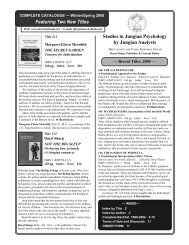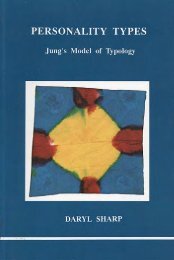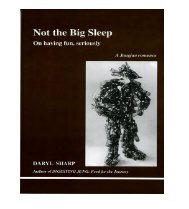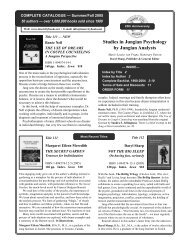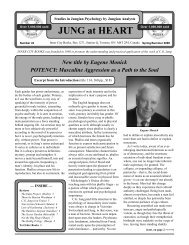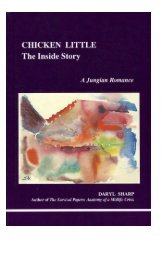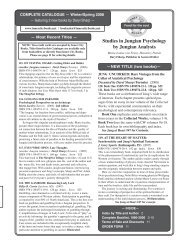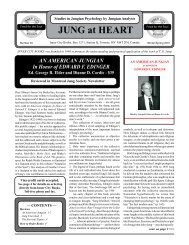Digesting Jung: Food for the Journey - Inner City Books
Digesting Jung: Food for the Journey - Inner City Books
Digesting Jung: Food for the Journey - Inner City Books
Create successful ePaper yourself
Turn your PDF publications into a flip-book with our unique Google optimized e-Paper software.
56 The Self-Regulation of <strong>the</strong> Psyche<br />
tached, and about which it revolves very much as <strong>the</strong> earth revolves<br />
round <strong>the</strong> sun—thus we come to <strong>the</strong> goal of individuation. 41<br />
So long as <strong>the</strong> self is unconscious, it corresponds to Freud’s superego<br />
and is a source of perpetual moral conflict. If, however, it is<br />
withdrawn from projection and is no longer identical with public<br />
opinion, <strong>the</strong>n one is truly one’s own yea and nay. The self <strong>the</strong>n functions<br />
as a union of opposites and thus constitutes <strong>the</strong> most immediate<br />
experience of <strong>the</strong> Divine which it is psychologically possible to<br />
imagine. 42<br />
Like any archetype, <strong>the</strong> essential nature of <strong>the</strong> Self is unknown<br />
and possibly unknowable, but its many and various manifestations—archetypal<br />
images—are known to us, in one <strong>for</strong>m or ano<strong>the</strong>r,<br />
as <strong>the</strong> content of dreams, myth and legend. <strong>Jung</strong> says it all:<br />
The self appears in dreams, myths, and fairytales in <strong>the</strong> figure of <strong>the</strong><br />
“supraordinate personality,” such as a king, hero, prophet, saviour,<br />
etc., or in <strong>the</strong> <strong>for</strong>m of a totality symbol, such as <strong>the</strong> circle, square,<br />
quadratura circuli, cross, etc. When it represents a complexio oppositorum,<br />
a union of opposites, it can also appear as a united duality,<br />
in <strong>the</strong> <strong>for</strong>m, <strong>for</strong> instance, of tao as <strong>the</strong> interplay of yang and yin,<br />
or of <strong>the</strong> hostile bro<strong>the</strong>rs, or of <strong>the</strong> hero and his adversary (archenemy,<br />
dragon), Faust and Mephistopheles, etc. Empirically, <strong>the</strong>re<strong>for</strong>e,<br />
<strong>the</strong> self appears as a play of light and shadow, although conceived<br />
as a totality and unity in which <strong>the</strong> opposites are united. 43<br />
Psychologically, uniting <strong>the</strong> opposites involves first recognizing<br />
<strong>the</strong>m in whatever conflict we are engaged in, and <strong>the</strong>n holding <strong>the</strong><br />
tension between <strong>the</strong>m. The extent to which we are successful in this<br />
difficult and often lengthy endeavor—<strong>the</strong> degree of wholeness we<br />
experience—can be called a manifestation of <strong>the</strong> Self, or, if one<br />
prefers, <strong>the</strong> grace of God.<br />
41 Ibid., par. 405.<br />
42 “Trans<strong>for</strong>mation Symbolism in <strong>the</strong> Mass,” Psychology and Religion, CW 11,<br />
par. 396.<br />
43 “Definitions,” Psychological Types, CW 6, par. 790.



